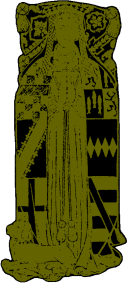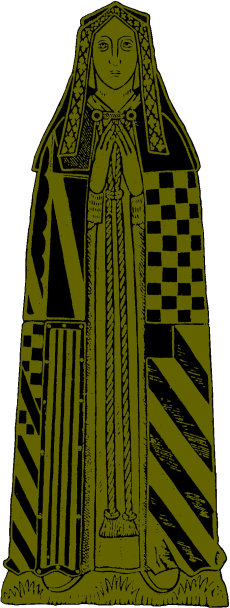

 |
 |
| FIG. 21.--Brass in the Scarisbrick Chapel of Ormskirk Church, co. Lancs., to a member of the Scarisbrick family of that name. Arms: Gules, three mullets in bend between two bendlets engrailed argent.(From a rubbing by Walter J. Kaye.) | FIG. 22.--Brass of Margaret (daughter of Henry Percy, Earl of Northumberland), second wife of Henry, 1st Earl of Cumberland, in Skipton Parish Church. Arms: On the dexter side those of the Earl of Cumberland, on the sinister side those of Percy. |
 |
 |
 |
 |
| FIG. 23.--Brass of Sir John D'Aubernoun at Stoke D'Abernon. Arms: Azure, a chevron or. (From a rubbing by Walter J. Kaye.) | FIG. 24.--Brass of Sir Roger de Trumpington at Trumpington. Arms: Azure, crusilly and two trumpets palewise or. (From a rubbing by Walter J. Kaye.) | FIG. 25.--Brass of Sir Robert de Septvans in Chartham Church. | FIG. 26.--Brass, of Sir William de Aldeburgh at Aldborough, Yorks. Arms: Azure, a fesse argent between three cross crosslets or. (From a rubbing by Walter J. Kaye.) |
*1 Here lieth Sir John D'Aubernoun, knight. On his soul may God have mercy.Heraldry figures more prominently in our second illustration, the brass to Sir Roger de Trumpington, 1289 (Fig. 24). This fine effigy lies under the canopy of an altar-tomb, so called, in the Church of St. Michael and All Angels, Trumpington, Cambridgeshire. It portrays the knight in armour closely resembling that already described, with these exceptions: the head rests upon a huge heaume, or tilting-helm, attached by a chain to the girdle, and the neck is here protected from side-thrusts by ailettes or oblong plates fastened behind the shoulders, and bearing the arms of Sir Roger. A dog here replaces the lion at the feet, the lance and pennon are absent, and the shield is rounded to the body. On this brass the arms not only occur upon the shield, but also upon the ailettes, and are four times repeated on the scabbard. They afford a good example of "canting" arms: "Azure, crusilly and two trumpets palewise or, with a label of five points in chief, for difference." It is interesting also to notice that the engraver had not completed his task, for the short horizontal lines across the dexter side of the shield indicate his intention of cutting away the surface of the field.
*1 "Monumental Brasses of Gloucestershire," by C. T. Davis. London: Phillimore & Co., 1899.A coat of arms occurs also at each corner of the slab: "Nos. 1 and 4 are on ordinary shields, and 2 and 3 on lozenges. Nos. 1 and 3 are charged with the same bearings as are on her mantle. No. 2, on a lozenge, quarterly, 1. Knevet; 2. Cromwell; 3. Tatshall; 4. Cailli; 5. De Woodstock; 6. paly of six within a bordure; 7. bendy of six, a canton; 8. or, a chevron gules (Stafford); 9. azure, a bend cottised between six lioncels rampant, or (de Bohun). No. 4 similar to No. 1, with the omission of 2 and 3."
*2 The arms are quoted by Mr. Davis from Bigland's "Gloucestershire," p. 539.
 |
| FIG. 27.--Brass of Elizabeth Knevet. |